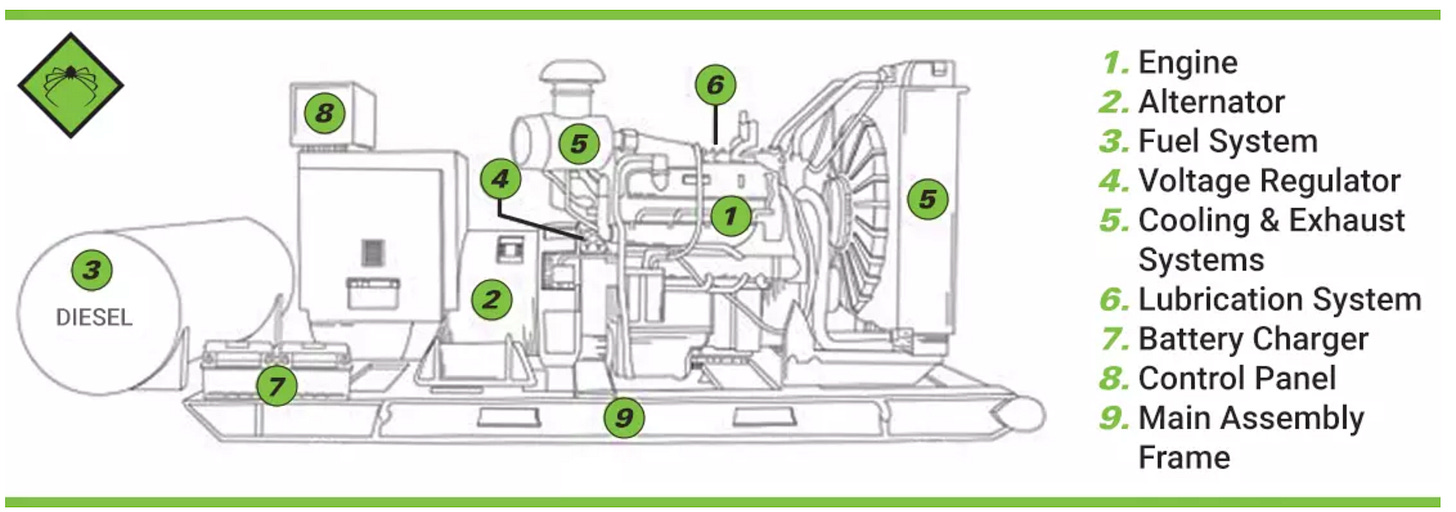Visting Mitsubishi Heavy Industries' partners in Johor
And an introduction to power generators and their role in data centers.
Dear subscribers,
If you are new to the newsletter, you might want to first consider our higher conviction idea concerning Johor, which essentially involves physically monitoring the ramp of a Wasion factory until it goes from Rmb 50M to Rmb 2B in revenue in two financial years.
We are happy to talk through that idea with our paid members, and would welcome any feedback or ideas on how we can further firm up our conviction on Wasion’s growth. Some of the entertaining ideas received include: installing a camera on a lamp post and renting an overlooking flat.
This is a short note explaining what power generators are and why data centers are driving such high demand for them.
We also report on our visit to the Johor factories of two MHI partners, Mech-Power (parent: $BQF.SI) and WDG Assembly (parent is $WASCO).
The report lays out a simple argument for BQF.SI making a strategic move that should be well received by the market.
We have a call with XMH’s management this evening which we will post an update on in the subscriber chat. Unusually, they suggested the call, in response to us pushing the idea described in this note.
Introduction
Many buildings have standby generators to protect life and assets. Hospitals need to keep the lights on, airports need to keep planes in the air, malls need to keep elevators and exit lighting on, virtually every public space has some reason to have emergency power.
Data centers are arguably a different breed entirely. Here, generators are not just for emergencies; they are a primary component of a facility’s uptime guarantee.
Data center generators must be able to support the entire DC, typically within a short amount of time, and run it indefinitely. This is a rather different proposition to merely having a generator for temporary emergency power in a a typical building, not least because you need to manage the heat, emissions, etc.
In very simple summary, a genset has three main parts:
The engine burns fuel to spin a shaft.
The alternator is, in simple terms, a magnet that turns the spinning shaft into electricity.
A control panel and switch gear synchonises the generator with the grid and other generators.
Source: ADE
Caterpillar and Cummins are big engine names. Mitsubishi Heavy Industries ($7011) is also a giant, respected for reliability and quality. You also have Weichai ($2338.HK) and Yuchai ($CYD), both Chinese domestic giants aiming to compete with CAT and Cummins.
Notably you also have the best of both worlds, the Western JV with a Chinese player, such as Chongqing Cummins Engine Co (partly owned by $2722, a favourite here) and MTU Yuchai (a Rolls Royce JV).
MHI does not make the alternator. We understand Cummins and Nidec are big players here.
Containerized generators for DCs
Instead of building a dedicated room inside the data center to house many generators, an entire assembly is pre-packaged into a weather-proof steel enclosure—often the size of a standard 40-foot shipping container.
You then put these containers outside, on the roof, in the parking lot, anywhere but precious server space. Further, they are essentially giant batteries that you truck and plug in just as the DC is ready for operation. See the photo of the Day One facility below:
WDG and Mitsubishi manufacture the engine.
XMH Holdings (through its subsidiary Mech-Power) puts the generator into a container together with systems like sound isolation, fire suppression, switchgear and breakers.
Below the paywall, we tour the Mech-Power and WDG facilities and provide our estimates of how much equipment they are manufacturing. We also lay out a simple argument for XMH making a positive announcement to the market in the near future.



